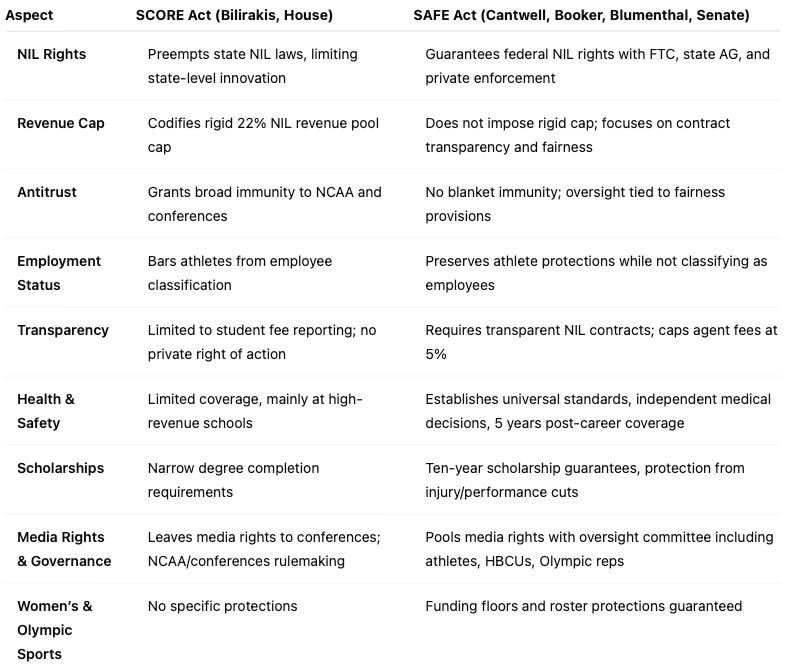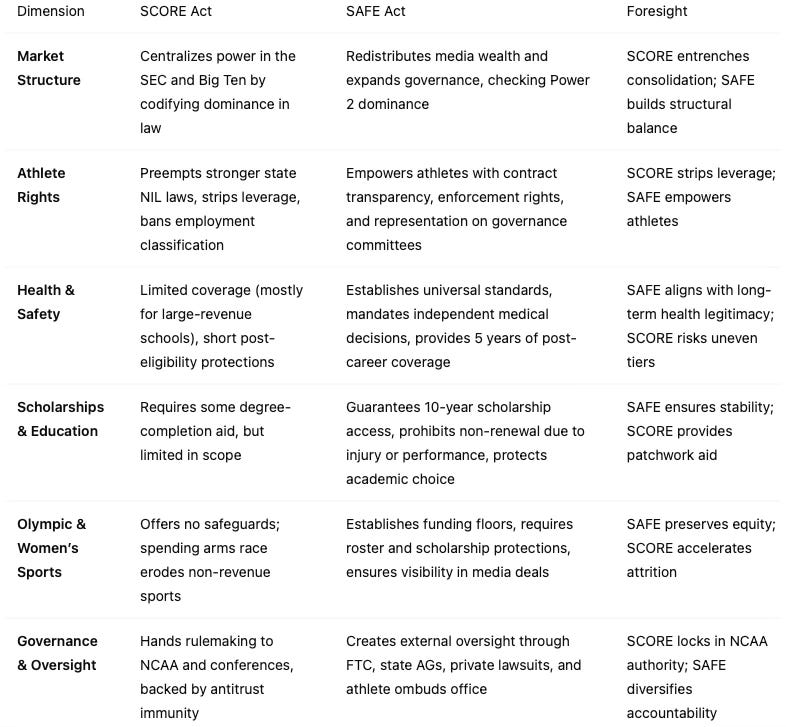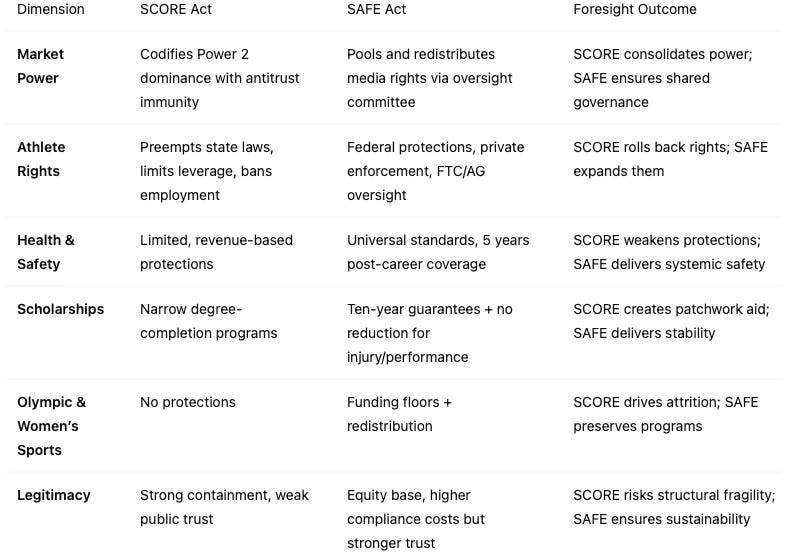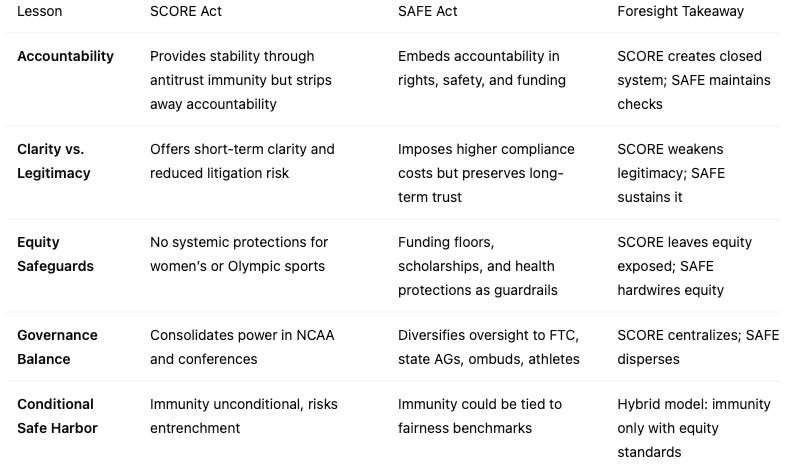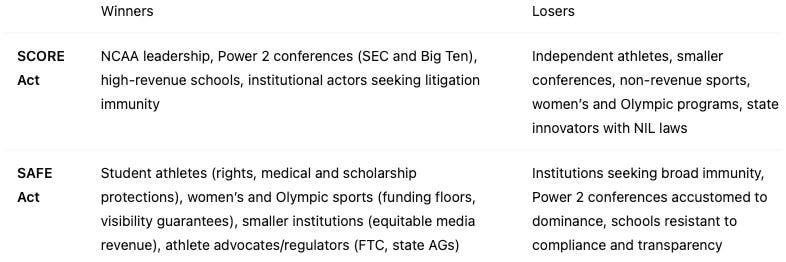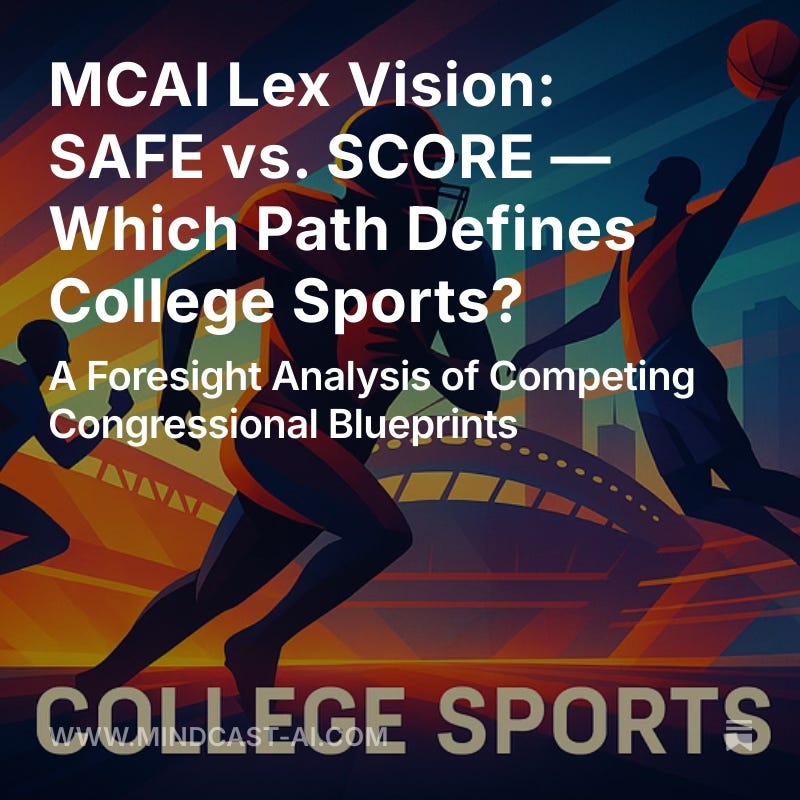MCAI Lex Vision: SAFE vs. SCORE Act — Which Path Should Define NCAA NIL?
A Foresight Analysis of Competing Congressional Blueprints
I. Executive Summary
Congress faces a momentous choice about the future of college sports: two competing bills will determine how NCAA Name-Image-Likeness (NIL) is governed.
The SCORE Act (Student Compensation and Opportunity through Rights and Endorsements Act) was introduced in the House in July 2025. As a counterproposal, U.S. Senators Maria Cantwell (D-Wash.), Cory Booker (D-N.J.), and Richard Blumenthal (D-Conn.), introduced the SAFE Act (Student Athlete Fairness and Enforcement Act) in September 2025.
Together, the SCORE and SAFE Acts highlight stark policy choices before Congress. Unlike SCORE, which centralizes authority and shields institutions, SAFE federalizes protections for athletes, expands health and education guarantees, and imposes enforceable oversight.
MindCast AI conducts analysis using Cognitive Digital Twins (CDTs), our proprietary foresight simulation architecture. CDTs model the behaviors of athletes, institutions, regulators, and conferences under different legal regimes. By stress-testing legislation through CDT simulations, we can see how statutes like SAFE and SCORE behave not just on paper, but under pressure—revealing whether they collapse, sustain, or evolve into legitimacy over time.
On August 26, MindCast AI published How the SCORE Act Codifies College Sports Inequality, which modeled how broad antitrust immunity could entrench inequities that Senator Cantwell warned about in her letter to 350 university leaders. That report showed how revenue gaps, playoff exclusion, and NIL preemption evolve into structural lock-ins once written into federal law. The report also proposed a conditional safe harbor—coupling immunity with equity benchmarks—as a legislative design principle. Section V below assess whether SAFE or SCORE embodies that principle.
Contact mcai@mindcast-ai.com to partner with us on foresight simulations for complex litigation and antitrust.
II. The Two Bills in Brief
Congress now has two very different bills on the table, each seeking to define the future of college sports. The SCORE Act emerges from the House and prioritizes clarity and institutional protection, while the SAFE Act is rooted in the Senate and prioritizes fairness and athlete protections. The following section sets out their major features side by side to illustrate just how divergent the two paths are. The table frames these distinctions clearly for comparison.
These contrasts show that SCORE favors institutional stability, while SAFE prioritizes athlete protections and equity. The choice of framework determines whether federal law entrenches inequality or creates safeguards for fairness.
The competing bills reflect fundamentally different visions of college athletics. SCORE looks backward to preserve institutional authority, while SAFE looks forward to embed fairness and equity as legislative norms.
III. Detailed SCORE vs. SAFE Act Comparison
Beyond the high-level provisions, the true test lies in how the bills shift the balance of power. The section looks at critical dimensions such as market structure, athlete rights, health, scholarships, and equity. Each row highlights how the SCORE and SAFE Acts approach the same issue differently, with foresight showing how those choices play out under stress. The table makes visible how legislative design translates into systemic outcomes.
The comparison demonstrates that SAFE consistently embeds accountability and fairness, while SCORE consistently reinforces concentration of power and inequality.
The contrast highlights the stakes: Congress can either lock in a Power 2 monopoly or legislate a more balanced system. SAFE aligns with long-term legitimacy; SCORE deepens systemic fragility.
IV. Foresight Matrix: SCORE vs SAFE Under Stress
Even laws that look balanced on paper can behave differently once enacted. This section presents a foresight stress test that simulates how SCORE and SAFE would function when pushed by institutional incentives, fiscal pressures, and athlete demands. By mapping key categories—market power, rights, health, equity—against projected outcomes, readers can see which framework sustains legitimacy and which risks collapse. The matrix condenses years of foresight modeling into an at-a-glance tool.
The stress test shows that SCORE buckles under pressure, entrenching inequities, while SAFE adapts with stronger protections that hold legitimacy over time.
Foresight modeling confirms that only structures with built-in accountability can withstand real-world stress. SAFE provides those guardrails, while SCORE relies on fragile assumptions of stability.
V. Structural Design Lessons
Comparing these bills also yields lessons about how to design legislation that endures. The section distills five key insights that cut across accountability, legitimacy, equity, governance, and the possibility of a hybrid safe harbor model. Each row explains how SCORE and SAFE handle the same structural question, and what foresight shows about the consequences. The lessons provide lawmakers a design template for balancing stability with fairness.
Legislative durability depends on embedding equity and accountability. SAFE offers a template for sustainability, while SCORE reveals the risks of immunity without conditions.
These lessons reinforce that sustainable reform requires Congress to couple immunity with enforceable fairness standards. Without conditions, SCORE risks repeating the failures of NCAA amateurism.
VI. Antitrust, Winners, and Market Outcomes
From an antitrust standpoint, the SAFE Act is the stronger framework. It avoids granting blanket immunity to NCAA and conferences, preserves enforcement through FTC, state attorneys general, and private rights of action, and ties oversight to fairness provisions. In contrast, the SCORE Act grants sweeping antitrust immunity, shielding dominant conferences and institutions while preempting state innovation, which risks codifying monopoly power.
These antitrust choices shape the broader market outcomes, producing clear winners and losers:
SAFE aligns antitrust principles with fairness and competitive balance, while SCORE prioritizes institutional protection at the expense of athletes and smaller schools.
The lesson from this section is clear: the legislative choice directly determines who benefits and who is left behind. SAFE redistributes opportunity and strengthens accountability, while SCORE entrenches privilege and weakens competition.
VII. Conclusion
Congress faces a choice that will echo for decades. Will lawmakers adopt SCORE’s institution-first clarity, SAFE’s athlete-first equity, or attempt a hybrid model that blends both? The conclusion underscores that college sports are not just games but civic infrastructure. Choices made now will determine whether reform means fairness or capture.
The overall foresight analysis confirms that SAFE offers structural sustainability while SCORE locks in fragility. Congress must decide whether to legislate for equity and long-term legitimacy, or entrench short-term containment and institutional dominance.
Appendix: Place in the MindCast AI Library
MindCast AI’s college sports publications now cover every major arena of influence:
MCAI Lex Vision: How the SCORE Act Codifies College Sports Inequality (Aug 2025) — www.mindcast-ai.com/p/scorecantwellletter. The publication analyzed Senator Cantwell’s letter and introduced conditional safe harbor as a legislative design principle. It demonstrated how antitrust immunity could entrench inequities, validated Cantwell’s warnings with foresight modeling, and proposed structured safeguards to turn critique into legislative design. The report positioned Congress as a new driver of consolidation, moving the debate from courts to Capitol Hill.
MCAI Lex Vision: Navigating the NCAA NIL Compliance Matrix (Jul 2025) — www.mindcast-ai.com/p/uwnil. A University of Washington case study on NIL settlement pressures and governance fragility. It highlighted how universities struggle to reconcile settlement requirements with SCORE Act provisions and executive order pressures. The analysis revealed compliance fragility and offered foresight scenarios for institutional risk management.
MCAI Lex Vision: Foresight Simulation of the SCORE Act and NCAA Settlement (Jul 2025) — www.mindcast-ai.com/p/scoreact. The publication stress-tested the SCORE Act with Cognitive Digital Twin simulations. It showed how rigid revenue ceilings and broad antitrust immunity provided initial clarity but eroded legitimacy under pressure. The foresight simulation forecasted long-term instability unless reforms embedded accountability and equity safeguards.
MCAI Lex Vision: Executive Foresight and the New Era of NCAA Institutional NIL Legitimacy (Jul 2025) — www.mindcast-ai.com/p/ncaaeo. The report analyzed the Trump Executive Order and its impact on NCAA governance coherence. It illustrated how federal scrutiny elevated the need for narrative integrity and institutional foresight. The conclusion was that compliance alone was insufficient, urging universities to adopt foresight-based governance practices.



